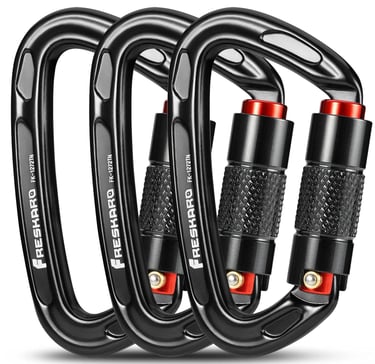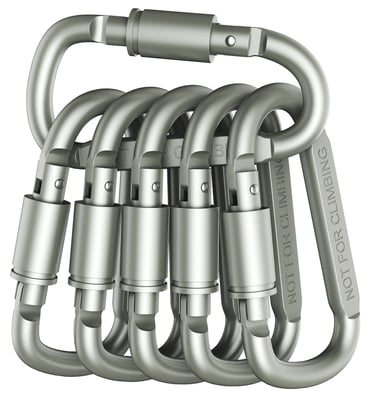The Versatility and Importance of Carabiners in Various Industries
SPORTS
6/21/20245 min read


Carabiners are essential tools that play a crucial role in a multitude of industries and activities, ranging from outdoor sports and climbing to safety equipment and aerospace applications. These versatile connectors come in various materials, each offering unique properties suited to specific uses. This blog will explore the different types of carabiners, their applications across various sectors, and the specific advantages of each material.
Types of Carabiners by Material
Aluminum Carabiners
Lightweight and Corrosion-Resistant: Aluminum carabiners are prized for their lightweight nature, making them ideal for applications where weight is a critical factor, such as in climbing and hiking. They are also resistant to corrosion, which is particularly beneficial for outdoor and marine environments.
Applications:
Outdoor Sports: Essential for climbing, hiking, and camping.
Pet Accessories: Commonly used in leashes and harnesses due to their light weight and durability.
Safety Equipment: Used in fall arrest systems and personal protective equipment (PPE).
Steel Carabiners
Strength and Durability: Steel carabiners are known for their exceptional strength and durability. They are capable of handling heavy loads and are resistant to wear and tear, making them suitable for industrial and heavy-duty applications.
Applications:
Safety Equipment: Widely used in rescue operations and fall protection systems.
Climbing Industry: Preferred in situations where maximum strength is required.
Construction and Industrial: Used for rigging and lifting heavy materials.
Titanium Carabiners
High Strength-to-Weight Ratio: Titanium carabiners offer an excellent strength-to-weight ratio, providing the benefits of both strength and lightness. They are also highly resistant to corrosion and extreme temperatures.
Applications:
Aerospace: Used in aircraft door mechanisms, parachutes, and spacecraft docking systems due to their lightweight and robust nature.
Outdoor Sports: Suitable for high-performance climbing and hiking gear.
Medical Equipment: Utilized in surgical instruments and implants due to their biocompatibility.
Brass Carabiners
Corrosion Resistance and Aesthetic Appeal: Brass carabiners are appreciated for their corrosion resistance and attractive appearance. They are commonly used in environments where exposure to moisture is a concern and where a decorative element is desired.
Applications:
Marine: Used in boating and sailing equipment.
Pet Accessories: Popular for leashes and collars.
Fashion and Jewelry: Incorporated into bags, belts, and accessories for their aesthetic appeal.
Plastic Carabiners
Lightweight and Cost-Effective: Plastic carabiners are lightweight and inexpensive, making them suitable for light-duty applications. They are not designed for heavy loads but are useful for everyday use and non-critical applications.
Applications:
Outdoor Sports: Used for organizing gear and accessories.
Pet Accessories: Suitable for light-duty leashes and tags.
Travel and Camping: Ideal for securing small items to backpacks and tents.
Zinc Carabiners
Economical and Durable: Zinc carabiners offer a balance between cost and durability. They are resistant to corrosion and are used in various applications where moderate strength is sufficient.
Applications:
Outdoor Sports: Used in hiking and camping gear.
Pet Accessories: Common in leashes and harnesses.
Industrial: Suitable for medium-duty lifting and securing tasks.
Copper Carabiners
Antimicrobial Properties: Copper carabiners are known for their antimicrobial properties, making them useful in environments where hygiene is critical. They are also corrosion-resistant and have an attractive appearance.
Applications:
Medical and Healthcare: Used in medical equipment and facilities.
Marine: Suitable for use in wet and corrosive environments.
Fashion and Jewelry: Employed in decorative and functional items.
Applications in Different Industries
Outdoor Sports Equipment Industry
Carabiners are indispensable in the outdoor sports equipment industry, providing essential functionality in activities like climbing, hiking, camping, and more.
Key Applications:
Climbing Rope and Harness: Carabiners connect climbers to ropes and harnesses, ensuring safety and stability.
Tent Setup: Used for securing tent structures and guy lines.
Backpack Attachments: Carabiners help attach additional gear to backpacks.
Hiking Poles: Carabiners secure poles to backpacks when not in use.
Camping Stove: Used to hang or secure camping stoves and other equipment.
Pet Accessories Industry
In the pet accessories industry, carabiners are crucial for ensuring the safety and comfort of pets during walks and activities.
Key Applications:
Leashes and Collars: Carabiners provide a secure and reliable connection between leashes and collars.
Harnesses: Used to attach harnesses securely, allowing for better control and safety.
Training Equipment: Carabiners are utilized in various training tools and accessories.
Climbing Industry
The climbing industry relies heavily on carabiners for safety and functionality. Different types of carabiners are used depending on the specific climbing activity and requirements.
Key Applications:
Belay Systems: Carabiners are essential for connecting belay devices and securing climbers.
Anchor Systems: Used to create secure anchor points during climbs.
Quickdraws: Carabiners are a critical component of quickdraws, allowing for easy clipping and unclipping during climbs.
Protection Devices: Used in conjunction with cams, nuts, and other protection devices.
Safety Equipment Industry
In the safety equipment industry, carabiners are vital for ensuring the safety of workers in various hazardous environments.
Key Applications:
Fall Arrest Systems: Carabiners are used in personal fall protection equipment to secure workers.
Rescue Operations: Used by emergency responders to secure rescue gear and victims.
Construction: Carabiners are utilized in securing tools and equipment at height to prevent accidents.
Hiking Industry
The hiking industry uses carabiners to enhance the functionality and convenience of hiking gear.
Key Applications:
Gear Organization: Carabiners help hikers organize and secure gear to backpacks.
Trail Markers: Used to attach trail markers and signs.
Water Bottles: Carabiners provide a convenient way to carry water bottles and other essentials.
Hiking Poles: Secure hiking poles when not in use.
Special Types of Carabiners
Outdoor Carabiners
Designed for rugged outdoor use, these carabiners are built to withstand harsh environmental conditions.
Features:
Durability: Made from materials like aluminum and steel for maximum strength and resistance to the elements.
Ease of Use: Designed with easy-to-operate gates for quick and secure clipping.
Lightweight Carabiners
Ideal for activities where weight is a critical factor, such as climbing and backpacking.
Features:
Material: Typically made from aluminum or titanium.
Design: Engineered to reduce weight without compromising strength.
Multi-functional Carabiners
These carabiners offer additional features and tools integrated into the design, enhancing their versatility.
Features:
Built-in Tools: May include screwdrivers, bottle openers, or wrenches.
Compact Design: Combines multiple functions in a single compact device.
Durable Carabiners
Built for long-lasting performance in demanding conditions, durable carabiners are essential for heavy-duty applications.
Features:
Material: Often made from steel or high-grade aluminum.
Construction: Designed to withstand high loads and repeated use.
Heavy-duty Carabiners
Designed for industrial and safety applications where maximum strength is required.
Features:
Load Capacity: Capable of handling very high loads.
Compliance: Meets stringent safety standards and regulations.
Aluminum Carabiners
Lightweight and corrosion-resistant, aluminum carabiners are versatile and widely used in various applications.
Features:
Weight: Extremely light, making them suitable for climbing and hiking.
Corrosion Resistance: Ideal for use in wet and marine environments.
Carabiners in Aerospace Applications
Carabiners are also integral to various aerospace applications, where reliability and safety are paramount.
Key Applications:
Aircraft Door Mechanisms: Carabiners ensure secure and reliable operation of aircraft doors.
Parachutes: Used in parachute deployment systems to ensure safe and controlled descent.
Aircraft Seat Belts: Provide secure connections in seat belt systems.
Aircraft Escape Slides: Carabiners are crucial for the deployment and operation of escape slides.
Spacecraft Docking Mechanisms: Used to secure connections between spacecraft modules.
Carabiners in Marine and Tactical Applications
In marine and tactical applications, carabiners are valued for their strength, durability, and resistance to harsh conditions.
Key Applications:
Fishing Nets: Carabiners secure fishing nets and other gear.
Diving Equipment: Used to attach and secure diving gear.
Tactical Backpacks: Carabiners attach additional gear to tactical backpacks.
Ski Poles: Secure ski poles to gear when not in use.
Conclusion
Carabiners are indispensable tools in a wide range of industries and applications, offering unique benefits based on their material composition and design. From lightweight aluminum carabiners for climbing to heavy-duty steel carabiners for industrial safety, the right carabiner can enhance safety, convenience, and efficiency in countless scenarios. Whether you're an outdoor enthusiast, a safety professional, or involved in aerospace engineering, understanding the various types of carabiners and their applications can help you choose the right tool for your needs.


